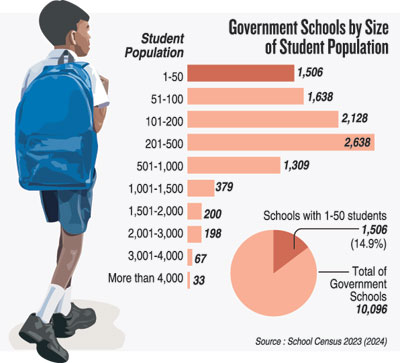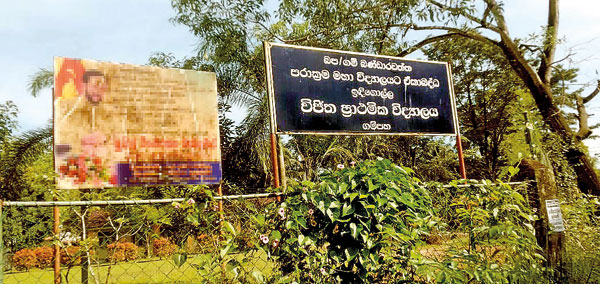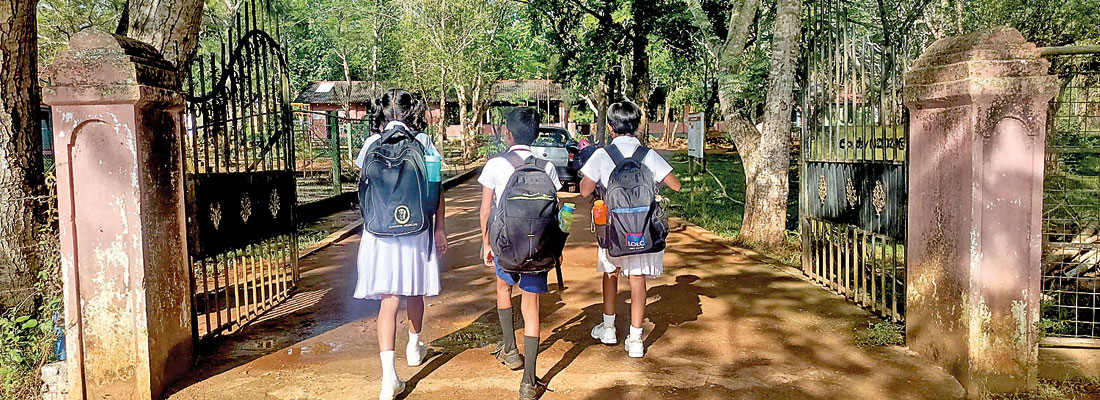News
Proposed school overhaul presents transport costs and potential dropout issues
View(s):- Plan triggers fears of under-enrolled rural school closures; Govt. says objective is to upgrade schools
By Sajeniya Sathanandan
The government’s plan to merge under-enrolled schools has triggered protests and confusion among students, parents, teachers, and education unions.
Most sections have been left pondering whether local schools with a low number of students will be permanently closed, triggering a chain of reactions and leading to a risk of increasing the school dropout rate, particularly in provinces.
There have been contradictory statements, with some of the government members conceding some of the schools will be closed, while others insist that schools will not be closed.
Both Prime Minister Harini Amarasuriya, in the capacity of Education Minister, and Deputy Minister of Education Madhura Senevirathna have insisted that schools will not be closed, but trade unions, teachers and parents said they refused to believe the statements, as some schools have already closed down.
Prime Minister Amarasuriya told a Parliamentary Sub-Committee on Education Reforms this week that schools would not be closed and that the policy was to consolidate and develop schools.

Speaking to the Sunday Times, Deputy Minister Senevirathna said, ‘‘The policy is regarding primary schools and a 3-kilometre radius, and the overall term for the initiative is not closing schools but rather enhancing opportunities, infrastructure, and human resources in schools.’’
Mr Senevirathna said 31 schools have been selected and are being developed. There are plans to select and develop more schools next year.
These upgraded schools will include subjects that may be missing in some districts and be equipped with basic sports facilities and the necessary teachers, he said.
“The policy for primary schools is to keep them as close as possible to the children’s residences, specifically within a 3-kilometre radius,” Dr Senevirathna explained.
Despite claims that no schools will be closed, President Anura Kumara Dissanayake told Parliament that low-enrolment schools will be merged or closed to create fully equipped schools.
It is claimed that the schools are not going to be shut down, yet schools are identified to be shut down.
President Dissanayaka told parliament that the purpose of the reform is to ensure that children complete 13 years of schooling and to create a system to prevent dropouts. He pointed out that in 2023 there were 98 government schools with no students and over 3,000 schools with fewer than 100 students. The education reform plans to reassess the school network and might merge or close certain low-enrolment schools to create a smaller number of fully equipped, high-quality schools.
Implementation of reassessing the school network is scheduled for 2026, starting with Grade 1 and Grade 6.
The National People’s Power manifesto, in the section on ‘Primary education’, assures a “government school system for primary education within 3 kilometres of one’s home or parents’ place of work.
The Sunday Times learns that the Education Ministry has so far identified 1,500 government schools with fewer than 50 students, and a restructuring programme is underway where some of the students will be transferred to schools nearer to them.
The move will lead to a closure of the schools, leaving students vulnerable to dropping out of the system, as some of them would not be able to afford going to a school further from home.
One issue is transport cost, as some of the students are able to attend schools as they are located within walking distance.
In the Western province, 87 schools are identified with fewer than 50 children, yet there aren’t any decisions taken to shut them down. In case the decision is taken to shut down certain schools, the children will be allowed to decide whether they want to be merged with another school or transferred to another school, an official said.
The government is collecting data to create a school mapping system, including the number of students and their willingness to attend the schools. Transport has not been planned as yet.
However, a senior official of the Western Province Ministry of Education said, “Shutting down certain schools because of low children’s enrolment is not the policy of the existing government.”
He said there are 87 schools in the Western Province with fewer than 50 students. Census data results have shown that not all families have children.
He also mentioned that transport calculations are still pending, and they do not yet have a concrete idea about arrangements.
They are collecting data, including the number of students and their willingness to attend the schools. The mapping stage is ongoing for all schools, as the provincial area contains 3,340 schools that need to be mapped.
The Sunday Times learns that in the Nuwara Eliya zone, certain Tamil primary schools had been chosen for closure, including Agra Tamil Vidyalaya in Agarapathana, Dell Tamil Vidyalaya in Agarapathana, Hilendaven Tamil Vidyalaya in Walapane, Brookside Tamil Vidyalaya in Walapane, Rabanoc Tamil Vidyalaya in Udapussallawa, Weliyoya Tamil Vidyalaya, Rushbrook Tamil Vidyalaya in Ramboda, Dansinan Two Tamil Vidyalaya and Thispane Tamil Vidyalaya.
Legislator V. S. Radhakrishnan said that the distance between schools is too much. There should ideally be a school every 3 kilometres. Especially in plantations and villages, the distance is often between 5 km and 7 km.
The education sector unions, among other concerns, said that if children are assigned to another school which is more than 10 kilometres away, the dropout rate might increase and their future becomes a question mark.
Unions have noted a Supreme Court order on the maximum number of students in a classroom, and the government directive to amalgamate schools will affect the court ruling.
President of the Education Professionals’ Association Ven. Ulapane Sumangala Thera said about 1,000 schools are targeted for closure in the first phase, planned to begin in January. Schools with low student numbers in Advanced Level sections are also being assessed. He said the plan involves closing these A-level sections first, leading to the full closure of those schools in the second phase.
He said the primary goal of the government is the reduction of the total number of schools. This is reportedly linked to the decreasing population, or declining birth rates.
It is asserted that the state has an obligation to provide education to children. Denying a school to a child within a 10-kilometre radius is deemed unacceptable for a responsible government, he said.
He claimed that the government has authorised national schools to admit more students. This allows schools to exceed the student count mandated by a Supreme Court order. The SC order sets the limit for the number of children per class at 30. However, the government has permitted schools to admit up to 40 children. This higher enrolment in national schools is underway, with interviews for admission to the first year and middle grades.
The union has highlighted the impracticality of children relocating within 5 kilometres, especially in remote areas such as hilly regions. Also, in areas like islands, if amalgamation occurs, children might not attend schools, as they are far and their parents cannot afford transport. The action is viewed as causing a major negative impact on free education.
Ceylon Teachers Union General Secretary Joseph Stalin said the suggestion of relocating students within 5 km is impractical. This is particularly difficult in remote regions and the hill country.
He said if small schools are closed, there is no guarantee that the students will attend the alternative, distant schools. In areas like islands where schools are already far apart, travel difficulties may prompt children from poor families to stay home.
Anil Pushpakumara, general secretary of the National Organisation of Retired Teachers and Principals, said rural schools present a big challenge in providing adequate and safe transport for students who will be relocated. In regions such as Mannar, northern Puttalam, Anuradhapura, Polonnaruwa, and Monaragala, public transport is also often severely limited in these areas.
He said the distances to school can be 4 to 5 km, which is significant, especially when the routes involve crossing dangerous environments like forests inhabited by elephants and other animals, rivers, or mountains. These are risks for children. If these critical transport and safety concerns are not addressed, student attendance will drop.
Upali M. Sedara, Director General of the National Institute of Education, said Sri Lanka currently has no minimum or maximum size requirement for schools. The main problem is that the school system is not cost-effective and creates a socialisation deficit. Many schools have more teachers than students, making it financially inefficient to pay high salaries for teachers handling classes with only one or two pupils, which also limits crucial peer interaction.
He said that under a previous rationalisation plan, designed to channel students through a series of schools, students were to be transferred to other schools after each completed grade, from Grade 1 to Grade 6 to Grade 9. The biggest challenge now is implementing the new plan without causing dropouts among the marginalised student population who rely on small schools closer to home. Comprehensive safety nets are essential to protect these vulnerable children.
Thurkadevi Mahendran, a Mullaitivu teacher, said the Education Ministry has ordered that small schools be merged with larger, nearby schools that have higher enrolment. Such mergers will reportedly start in January. Students and teachers from the smaller institution would be transferred to the larger school.
| Indigolla school gives way to native medicine uni. One of the schools to be closed down is the Vijitha Primary School in Indigolla, Gamapaha district. A letter from the Western Province Ministry of Education to the Zonal Education Director of Gampaha states that the school is to be closed and handed over to the Gampaha Wickramarachchi University of Indigenous Medicine, as their faculty of indigenous social sciences and management studies and faculty of indigenous health sciences and technology do not have space. The university has been informed that the school premises will be released on the basis that it will be acquired by the ministry whenever needed. The letter also says that the children will be transferred to other suitable schools. In Jaffna, the Kantharmadam Saivapragasa Vidyalayam was closed down recently due to a lack of students. The school is converted into a Divisional Education Office for the Nallur region.
| |
| School closures and shattered dreams: Poor villagers cite unaffordable transport costs As fears mount over the closure of under-enrolled schools in remote villages, parents are urging the government to abandon the plan, citing potential disruption to their children’s education. The Kothalakemiyawa Primary School, located about 10 km off Anamaduwa town, was once a well-attended school. It now has fewer than 50 students. In Kothalakemiyawa, villagers say if the school is closed, they would have to send their children to Anamaduwa town, and they cannot meet the transport cost. Dinusha Priyangani, whose three children are in grades three, five and nine in the village school, says the family cannot meet the transport cost if her children are transferred to the town school.
“Please do not close the school, as our children’s education will be interrupted,” she appealed to the authorities. Pushpa Kumari, another parent, says a change of school will disrupt her child’s studies. “We do not have the economic strength to send our child to the town school,” she adds. She says the village school is just five minutes’ walk from her house, and it is convenient for her child to get to and from school. But if the child is sent to the nearest school in town, they will have to arrange transport—an additional burden on the family coffers. Dhammika Tennakoon, another parent, says her husband works as a labourer, and with his meagre income, he cannot afford the transport costs to a distant school. “The closure of the village school will end our child’s school life,” she laments. Similar concerns are voiced by parents in other poverty-stricken villages across the Puttalam district. They say the closure of under-enrolled village schools and the transfer of students to distant schools in town will shatter their dreams of giving their children a better life through education. Pix and text by
|
The best way to say that you found the home of your dreams is by finding it on Hitad.lk. We have listings for apartments for sale or rent in Sri Lanka, no matter what locale you're looking for! Whether you live in Colombo, Galle, Kandy, Matara, Jaffna and more - we've got them all!



